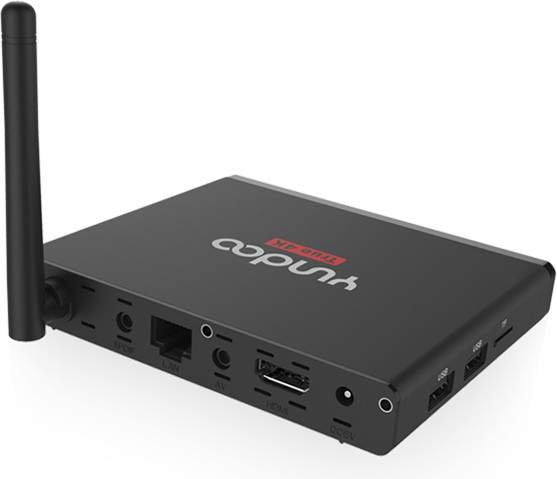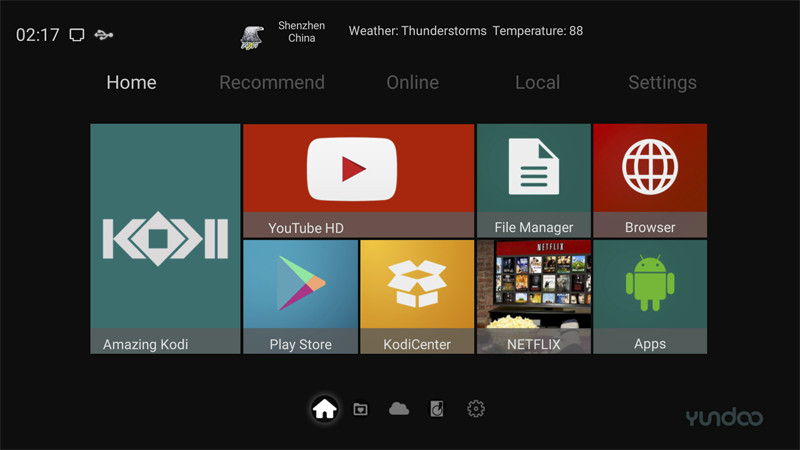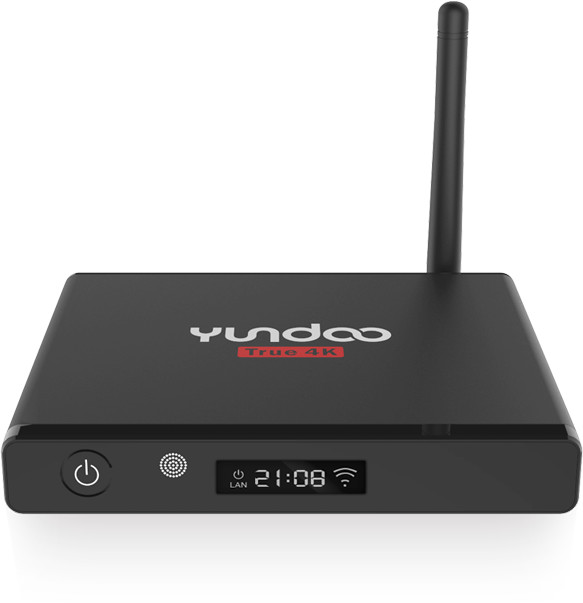Most TV boxes on the market comes with DDR3 memory, but YUNDOO Y7 TV box based on Amlogic S905X processor instead comes with 2GB DDR4 memory, with the company claiming 50% higher bandwidth compared to DDR3 memory.
- SoC – Amlogic S905X quad core Cortex A53 processor @ 1.5 GHz with Penta-core Mali-450MP GPU @ 750MHz+
- System Memory – 2GB DDR4 (bandwidth up to increased 50% compared to DDR3)
- Storage – 16GB eMMC flash + micro SD port
- Video Output – HDMI 2.0 with HDR and CEC support up to 4K2K @ 60 Hz, AV port
- Audio Output – HDMI, AV, and coaxial S/PDIF
- Connectivity – 10/100M Ethernet, dual band WiFi 802.11 b/g/n and Bluetooth 4.0
- USB – 2 x USB 2.0 port
- Misc – Power button, IR receiver, LED screen
- Power Supply – 5V
- Dimensions – TBD (metal housing)
 The device runs Android 6.0, and is said to come with a user interface designed by XPoloV designer team based in the USA.
The device runs Android 6.0, and is said to come with a user interface designed by XPoloV designer team based in the USA.
Which applications will benefit from higher memory bandwidth? I’m not entirely sure, but I’d assume applications moving a lot of data, such as 4K video players and possibly games should benefit from faster memory.

I could not find availability nor price information for the device, but you’ll find some more details on Yundoo Y7 product page. Yundoo and Nexbox brands appear to be managed by the same company. [Update: Yundoo Y7 is up for pre-order on GeekBuying for $57.99 with 2GB+16GB, and $43.99 with 1GB+8GB. Shipping is scheduled for next week (1GB RAM) and next month (2GB RAM)]

Jean-Luc started CNX Software in 2010 as a part-time endeavor, before quitting his job as a software engineering manager, and starting to write daily news, and reviews full time later in 2011.
Support CNX Software! Donate via cryptocurrencies, become a Patron on Patreon, or purchase goods on Amazon or Aliexpress





Please don’t copy the ‘speed increased 50% compared DDR3′ claim. This is only for the average clueless TV box customer to get the impression ‘everything is 50% faster’ since this box uses 4 of these DDR thingies instead of 3.
Memory bandwidth might be increased. Whether that affects specific use cases and real-world performance or not is a different thing.
@tkaiser
I think it was clear that only memory would be 50% faster, not the complete system. Anyway, I’ve changed “speed” to “bandwidth”. From 3 to 4 “thingies” would only be 33% though 🙂
-5 points for designe 🙁
default android TV launcher looks much better
don’t think this will have any noticable effect for a media center, would been better if they invested in a gigabit nic
@jeroen
I’ve received updated specs for S905X this week, and it does not support Gigabit Ethernet at all. There’s not even a GbE MAC.
@tkaiser
In modern Android\Java computing, the CPU is mostly idling for RAM to fill up the L2.
So a 50% increase in memory bandwidth > 50% increase in CPU clock rates.
@RK
That sounds great, so then we don’t speak about 1.5 GHz max for S905/S905X but 2250 MHz instead?!?!!?? That’s even more than those Amlogic cheaters promised. Theguyuk will be silent for ever 😉
I have to admit stopping to look into Java ‘performance’ maybe 20 years ago when watching an ‘application’ constantly needing more than 1GB memory on Sun servers equipped with just 256MB physical DRAM. I got already the impression that there might be something wrong 😉
@RK
Wholeheartedly answering: If this is the case the more memory bandwidth the better. But at the moment I consider this just an usual marketing claim (someone got a bunch of cheap B-grade DDR4 chips, DRAM clockspeed has to be lowered a lot to avoid crashed/freezes but marketing thinks ‘hey 4 is more than 3, let’s make a 50% speed gain out of it’. At least things like this are what we see every day in this market segment)
According to Jean-Luc’s tests S905X is overall slower, maybe they did not only crippled networking but also the memory controller? And using DDR4 now might be one of the ways to get back the speeds possible with S905/DDR3? Useless to speculate, it would needed meaningful tests (excluding throttling to get a sane baseline of numbers)
@tkaiser
Nice to know you still think of me????
ZTE were showing ddr4 back in Jan 2016.
The ZTE Android TV box – model number: ZXV10 B800S2 .
Wonder if this make will have more luck?
@Theguyuk
Did you understand what @RK explained? How much faster is S905X idling/waiting for data from DRAM at 2 GHz compared to running at just 1.5 GHz? 😛
@tkaiser
You will recall I mentioned ages back on another thread that a CPU is like a orchestra and needs a conductor to control everyone working together.
Memory to CPU flow has been around ages that’s why modern CPU have several caches. Not just AMLogics problem, neither does it destract from specification lies and cheats, let alone contempt for customer reporting it.. ☺
Nvidia Shield TV uses DDR 4
10/100 ?? why oh why 🙁 I`ve seen a few boxes recently… thought I might take a stab at.. then I read 10/100M ethernet 🙁
@Darren
There is nothing in that box that might be able to handle more than 100M bit of data. So there is nothing to use a giga bit ethernet connection for.
@Slothdnk
USB2.0 performance of S905 (tested with ODROID-C2) is pretty good to my surprise (since it was/is not that great with S805/ODROID-C1). For NAS use cases with an USB connected disk Fast vs. Gigabit Ethernet makes a difference of below 10MB/s vs. +35 MB/s while S905’s GbE implementation maxes out at ~935Mbits/sec with approriate settings.
Seems it depends on the use case (added NAS functionality or not — but no idea how good this works as long as these devices are running Android anyway). I know of a system house testing out database mirrors with cheap S905 based Beelink Mini MX using Armbian as data/database replication mirrors. Since GbE.
Why do people keep moaning about gigabit when they know the S905X doesn’t support it…
@tkaiser it’s not a marketing claim. DDR4 has twice the Memory clock & I/O bus clock resulting in doubled transfer rates.
If anything, claiming a mere 50% increase (over a 100% theoretical increase) is playing it safe or having trouble keeping up with the RAM due to a bad \ inefficient design* causing bottlenecks elsewhere.
*a superscaler architecture issue. Not ARM\Intel\ specific vendor problem.
@RK
All understood. But what about the memory controller implementation and the specific batch of DDR chips used? I remember that a customer using the faster DDR4 modules in his servers ended up with less memory bandwidth in the end due to some stuff I didn’t understand (maybe used too much modules in parallel, fortunately we don’t support the hardware there). I was talking about stuff like that. That DDR4 is faster than DDR3 by specs is understood (and I’m very keen on seeing LPDDR4 in the wild since this allows on-die ECC)
It is like RK mentioned, the whole system suffers wasted time if component parts have to idle, wait around, next piece of work is not available. Faster DDR is one thing but can the SOC process it quick enough or does it get to much work at once. Or like RK mentioned is the internal SOC design struggling to keep the workload flowing with work, due to slow delivery or removal of work/job finished.
The reason my Nvidia Tegra 4 based tablet is so fast is partly due to the memory the Nvidia tegra note uses ( amongst other things ).
Yundoo Y7 is up for pre-order on GeekBuying -> http://www.geekbuying.com/item/YUNDOO-Y7-Android-6-0-Amlogic-S905X-2GB-DDR4-16GB-EMMC-TV-BOX-372647.html
$58 for 2GB+16GB with delivery scheduled in 27 days
$44 for 1GB+8GB with delivery scheduled in 7 days.
@cnxsoft
So if this DDR4 box catches on and since enybox have a option for one, might we see more?
Enybox model em92. http://www.enybox.com/En/product/html/?231.html
I notice on their website the claim, it is the worlds first Android TV box with DDR4 ! , nice of them to ignore the Nvidia shield TV and the over priced Droidstar Titan.
Best to avoid, zero support from that company mentioned.